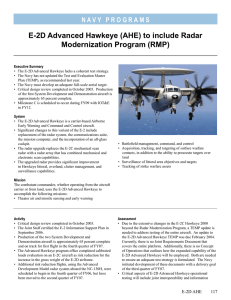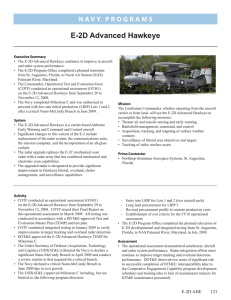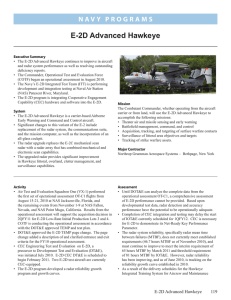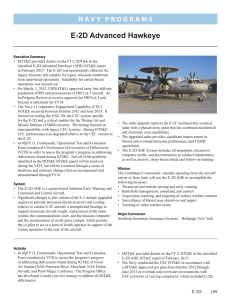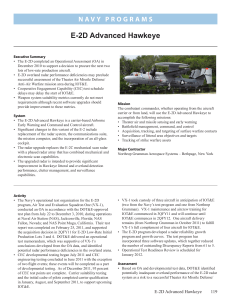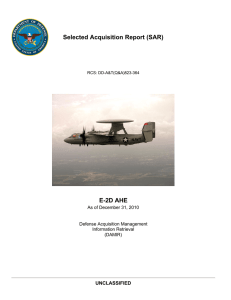E-2D Advanced Hawkeye (AHE) to include Radar Modernization Program (RMP)
advertisement
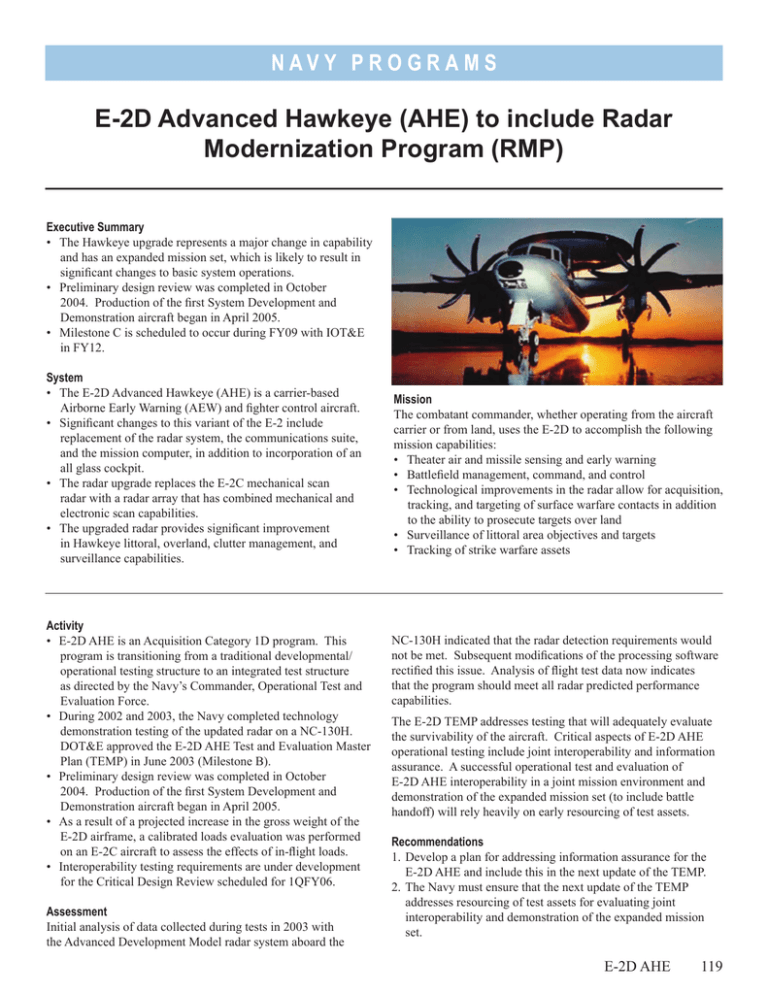
N AV Y P R O G R A M S E-2D Advanced Hawkeye (AHE) to include Radar Modernization Program (RMP) Executive Summary • The Hawkeye upgrade represents a major change in capability and has an expanded mission set, which is likely to result in significant changes to basic system operations. • Preliminary design review was completed in October 2004. Production of the first System Development and Demonstration aircraft began in April 2005. • Milestone C is scheduled to occur during FY09 with IOT&E in FY12. System • The E-2D Advanced Hawkeye (AHE) is a carrier-based Airborne Early Warning (AEW) and fighter control aircraft. • Significant changes to this variant of the E-2 include replacement of the radar system, the communications suite, and the mission computer, in addition to incorporation of an all glass cockpit. • The radar upgrade replaces the E-2C mechanical scan radar with a radar array that has combined mechanical and electronic scan capabilities. • The upgraded radar provides significant improvement in Hawkeye littoral, overland, clutter management, and surveillance capabilities. Activity • E-2D AHE is an Acquisition Category 1D program. This program is transitioning from a traditional developmental/ operational testing structure to an integrated test structure as directed by the Navy’s Commander, Operational Test and Evaluation Force. • During 2002 and 2003, the Navy completed technology demonstration testing of the updated radar on a NC-130H. DOT&E approved the E-2D AHE Test and Evaluation Master Plan (TEMP) in June 2003 (Milestone B). • Preliminary design review was completed in October 2004. Production of the first System Development and Demonstration aircraft began in April 2005. • As a result of a projected increase in the gross weight of the E-2D airframe, a calibrated loads evaluation was performed on an E-2C aircraft to assess the effects of in-flight loads. • Interoperability testing requirements are under development for the Critical Design Review scheduled for 1QFY06. Assessment Initial analysis of data collected during tests in 2003 with the Advanced Development Model radar system aboard the Mission The combatant commander, whether operating from the aircraft carrier or from land, uses the E-2D to accomplish the following mission capabilities: • Theater air and missile sensing and early warning • Battlefield management, command, and control • Technological improvements in the radar allow for acquisition, tracking, and targeting of surface warfare contacts in addition to the ability to prosecute targets over land • Surveillance of littoral area objectives and targets • Tracking of strike warfare assets NC-130H indicated that the radar detection requirements would not be met. Subsequent modifications of the processing software rectified this issue. Analysis of flight test data now indicates that the program should meet all radar predicted performance capabilities. The E-2D TEMP addresses testing that will adequately evaluate the survivability of the aircraft. Critical aspects of E-2D AHE operational testing include joint interoperability and information assurance. A successful operational test and evaluation of E-2D AHE interoperability in a joint mission environment and demonstration of the expanded mission set (to include battle handoff) will rely heavily on early resourcing of test assets. Recommendations 1. Develop a plan for addressing information assurance for the E-2D AHE and include this in the next update of the TEMP. 2. The Navy must ensure that the next update of the TEMP addresses resourcing of test assets for evaluating joint interoperability and demonstration of the expanded mission set. E-2D AHE 119 N AV Y P R O G R A M S 3. The program manager must address interoperability shortfalls and integrated test content in the next update of the TEMP. 120 E-2D AHE
